名词动词形容词变化规则
英语形式变化规则
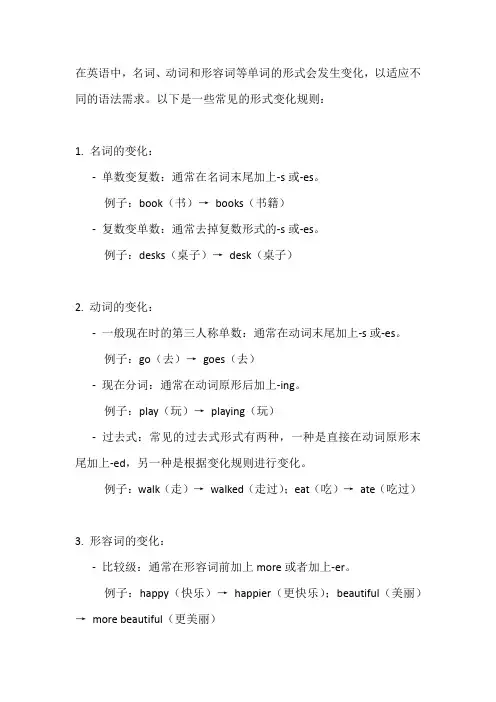
在英语中,名词、动词和形容词等单词的形式会发生变化,以适应不同的语法需求。
以下是一些常见的形式变化规则:
1. 名词的变化:
-单数变复数:通常在名词末尾加上-s或-es。
例子:book(书)→books(书籍)
-复数变单数:通常去掉复数形式的-s或-es。
例子:desks(桌子)→desk(桌子)
2. 动词的变化:
-一般现在时的第三人称单数:通常在动词末尾加上-s或-es。
例子:go(去)→goes(去)
-现在分词:通常在动词原形后加上-ing。
例子:play(玩)→playing(玩)
-过去式:常见的过去式形式有两种,一种是直接在动词原形末尾加上-ed,另一种是根据变化规则进行变化。
例子:walk(走)→walked(走过);eat(吃)→ate(吃过)
3. 形容词的变化:
-比较级:通常在形容词前加上more或者加上-er。
例子:happy(快乐)→happier(更快乐);beautiful(美丽)→more beautiful(更美丽)
-最高级:通常在形容词前加上most或者加上-est。
例子:happy(快乐)→happiest(最快乐);beautiful(美丽)→most beautiful(最美丽)
需要注意的是,英语中还存在一些不规则变化的单词,它们的形式变化与上述规则不同。
因此,在学习英语时,除了掌握常见的形式变化规则,还需要特别关注不规则变化的单词。
名词,动词,形容词变化规则
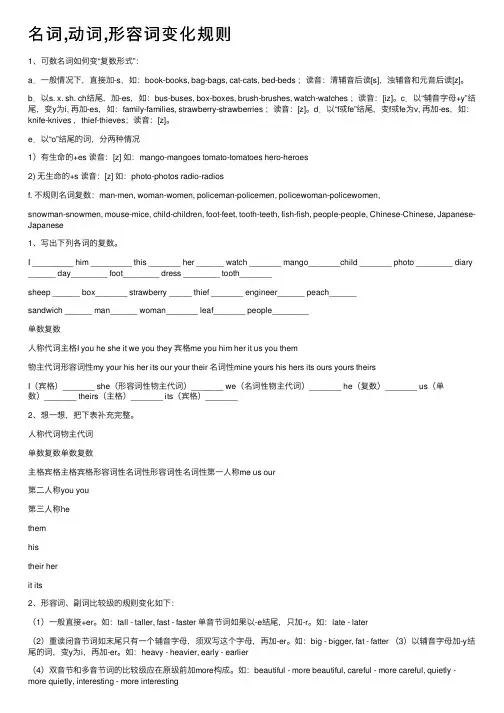
名词,动词,形容词变化规则1、可数名词如何变“复数形式”:a.⼀般情况下,直接加-s,如:book-books, bag-bags, cat-cats, bed-beds ;读⾳:清辅⾳后读[s],浊辅⾳和元⾳后读[z]。
b.以s. x. sh. ch结尾,加-es,如:bus-buses, box-boxes, brush-brushes, watch-watches ;读⾳:[iz]。
c.以“辅⾳字母+y”结尾,变y为i, 再加-es,如:family-families, strawberry-strawberries ;读⾳:[z]。
d.以“f或fe”结尾,变f或fe为v, 再加-es,如:knife-knives ,thief-thieves;读⾳:[z]。
e.以“o”结尾的词,分两种情况1)有⽣命的+es 读⾳:[z] 如:mango-mangoes tomato-tomatoes hero-heroes2) ⽆⽣命的+s 读⾳:[z] 如:photo-photos radio-radiosf. 不规则名词复数:man-men, woman-women, policeman-policemen, policewoman-policewomen,snowman-snowmen, mouse-mice, child-children, foot-feet, tooth-teeth, fish-fish, people-people, Chinese-Chinese, Japanese-Japanese1、写出下列各词的复数。
I _________ him _________ this _______ her ______ watch _______ mango_______child _______ photo ________ diary ______ day________ foot________ dress ________ tooth_______sheep ______ box_______ strawberry _____ thief _______ engineer______ peach______sandwich ______ man______ woman_______ leaf_______ people________单数复数⼈称代词主格I you he she it we you they 宾格me you him her it us you them物主代词形容词性my your his her its our your their 名词性mine yours his hers its ours yours theirsI(宾格)_______ she(形容词性物主代词)_______ we(名词性物主代词)_______ he(复数)_______ us(单数)_______ theirs(主格)_______ its(宾格)_______2、想⼀想,把下表补充完整。
小学英语素材-名词、动词、形容词、副词的六种变化规则 全国通用
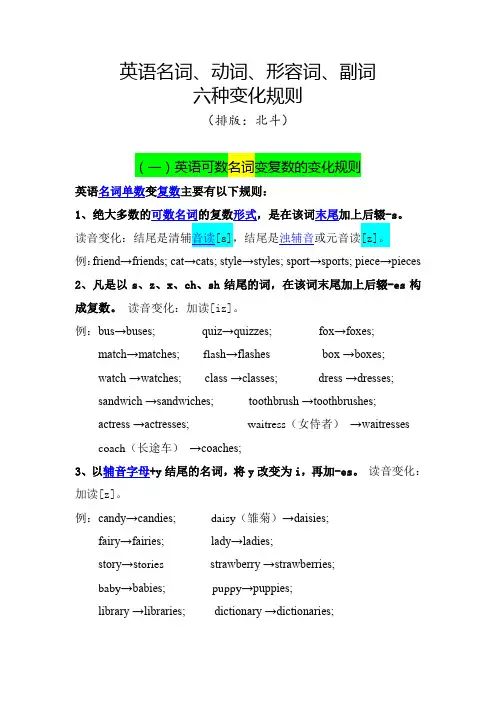
英语名词、动词、形容词、副词六种变化规则(排版:北斗)(一)英语可数名词变复数的变化规则英语名词单数变复数主要有以下规则:1、绝大多数的可数名词的复数形式,是在该词末尾加上后辍-s。
,结尾是浊辅音或元音读[z]。
例:friend→friends; cat→cats; style→styles; sport→sports; piece→pieces 2、凡是以s、z、x、ch、sh结尾的词,在该词末尾加上后辍-es构成复数。
读音变化:加读[iz]。
例:bus→buses;quiz→quizzes; fox→foxes;match→matches; fla sh→flashes box →boxes;watch →watches; class →classes; dress →dresses;sandwich →sandwiches; toothbrush →toothbrushes;actress →actresses;waitress(女侍者)→waitressescoach(长途车)→coaches;3、以辅音字母+y结尾的名词,将y改变为i,再加-es。
读音变化:加读[z]。
例:candy→candies;daisy(雏菊)→daisies;fairy→fairies; lady→ladies;story→s tories strawberry →strawberries;baby→babies; puppy→puppies;library →libraries;dictionary →dictionaries;cherry →cherries;activity →activities4、以-o结尾的名词(有生命的加es,无生命的加s)读音变化:加读[z]。
例:tomato→tomatoes;potato→potatoes;zoo→ zoos;piano→pianos;photo→photos;5、以-f或-fe结尾的名词,多为将-f或-fe改变为-ves,但有例外。
初中英语名词、动词、形容词各形式及变化规则
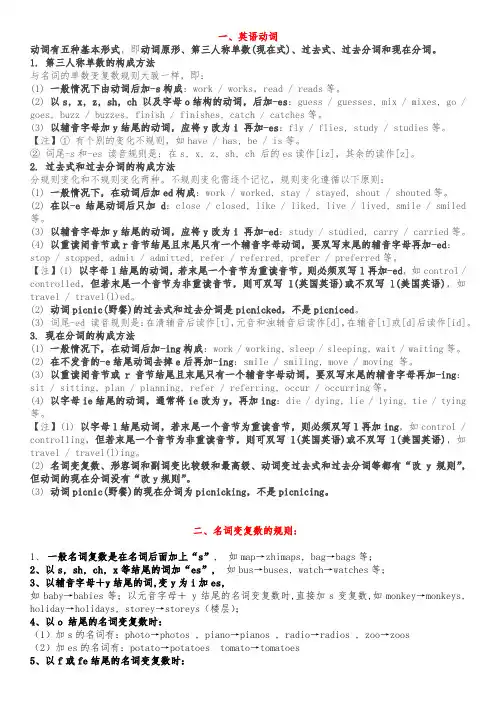
一、英语动词动词有五种基本形式,即动词原形、第三人称单数(现在式)、过去式、过去分词和现在分词。
1. 第三人称单数的构成方法与名词的单数变复数规则大致一样,即:(1) 一般情况下由动词后加-s构成:work / works,read / reads等。
(2) 以s, x, z, sh, ch 以及字母o结构的动词,后加-es:guess / guesses, mix / mixes, go / goes, buzz / buzzes, finish / finishes, catch / catches等。
(3)以辅音字母加y结尾的动词,应将y改为i 再加-es:fly / flies, study / studies等。
【注】①有个别的变化不规则,如have / has, be / is等。
②词尾-s和-es 读音规则是:在s, x, z, sh, ch 后的es读作[iz],其余的读作[z]。
2. 过去式和过去分词的构成方法分规则变化和不规则变化两种。
不规则变化需逐个记忆,规则变化遵循以下原则:(1) 一般情况下,在动词后加ed构成:work / worked, stay / stayed, shout / shouted等。
(2) 在以-e结尾动词后只加d:close / closed, like / liked, live / lived, smile / smiled 等。
(3)以辅音字母加y结尾的动词,应将y改为i 再加-ed:study / studied, carry / carried等。
(4) 以重读闭音节或r音节结尾且末尾只有一个辅音字母动词,要双写末尾的辅音字母再加-ed:stop / stopped, admit / admitted, refer / referred, prefer / preferred等。
【注】(1) 以字母l结尾的动词,若末尾一个音节为重读音节,则必须双写l再加-ed,如control / controlled,但若末尾一个音节为非重读音节,则可双写l(英国英语)或不双写l(美国英语),如travel / travel(l)ed。
英语形容词-名词-动词-副词-互变方法规律
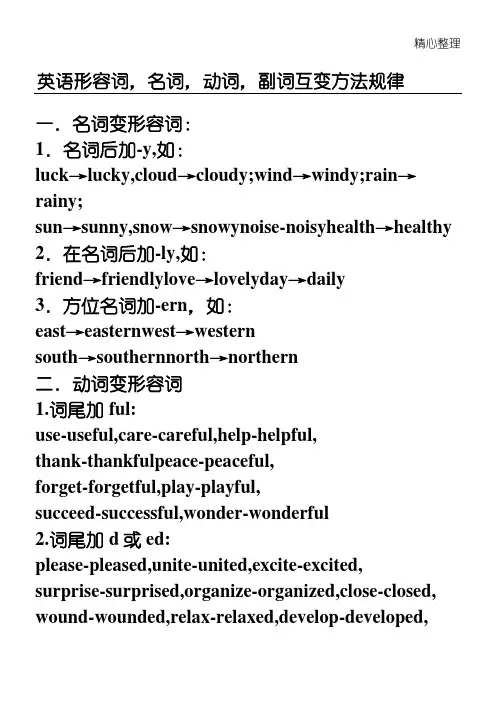
精心整理英语形容词,名词,动词,副词互变方法规律一.名词变形容词:1.名词后加-y,如:luck→lucky,cloud→cloudy;wind→windy;rain→rainy;sun→sunny,snow→healthy2.在名词后加-ly,如:friend→friendlylove→3.方位名词加-erneast→south→1.forget-forgetful,play-playful,succeed-successful,wonder-wonderful2.词尾加d或ed:please-pleased,unite-united,excite-excited,surprise-surprised,organize-organized,close-cl osed,wound-wounded,relax-relaxed,develop-developed, appreciate-appreciated,frustrate-frustrated, interest-interested,annoy-annoyed,use-used, frighten-frightened,crowd-crowded,thrill-thrilled,pollute-polluted3.词尾加ing:interest-interesting,surprise-surprising,live-livingrock-rocking,sleep-sleeping4.词尾变y为i,加ed:worry-worried,marry-married,fry-fried,terrify-terrifiedsatisfy-satisfied5.词尾加able:know-knowledgeable,enjoy-enjoyabe,suit-suitabl e,adjust-adjustable,comfort-comfortable6.其它:lose-lost,fool-foolish,live-livelysleep-sleepy/sleeping/asleep,wake-awake,taste-tastycational,world-worldwide例词1.2.以le为lypossible----possiblyterrible----terriblycomfortable----comfortablygentle----gentlysimple----simply3.以y结尾的形容词变y为ilyeasy----easilyangry----angrilynoisy----noisilyhappy----happilyheavy----heavilyhealthy----healthily不规则变化fast----fastearly----earlyhigh----highhard----hardlate----late形容词和副词为完全不同的单词good----well需要去掉字母e的单词true----trulygentle----gentlyterrible----terribly虽然以ly结尾,但却是形容词,不能直接用来修饰动词friendlylivelylovelylonelyLikely式。
英语形容词,名词,动词,副词 互变方法规律
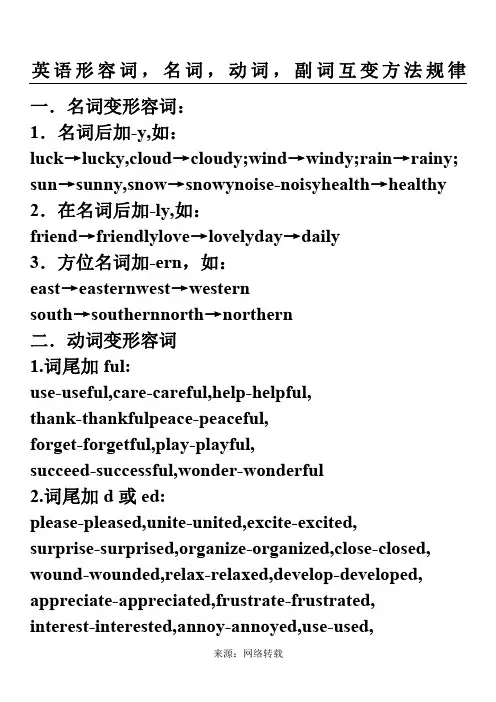
英语形容词,名词,动词,副词互变方法规律一.名词变形容词:1.名词后加-y,如:luck→lucky,cloud→cloudy;wind→windy;rain→rainy; sun23eastsouth1.2.please-pleased,unite-united,excite-excited,surprise-surprised,organize-organized,close-closed, wound-wounded,relax-relaxed,develop-developed, appreciate-appreciated,frustrate-frustrated,interest-interested,annoy-annoyed,use-used,frighten-frightened,crowd-crowded,thrill-thrilled, pollute-polluted3.词尾加ing:interest-interesting,surprise-surprising,4.5.know-knowledgeable,enjoy-enjoyabe,suit-suitable,adjust-adjustable,comfort-comfortable6.其它:lose-lost,fool-foolish,live-livelysleep-sleepy/sleeping/asleep,wake-awake,taste-tastyspeak-spoken,break-broken,die-dead,educate-aducatio nal,world-worldwide三.形容词变副词规律小结例词1.2.以3.以变yangry----angrilynoisy----noisilyhappy----happilyheavy----heavilyhealthy----healthily不规则变化本身既是形容词也是副词,无需改变fast----fastearly----earlyhigh----high词friendlylivelylovelylonelyLikely有些形容词本身即为副词,同时也有加ly的副词形式。
英语词性转换规则大全
英语词性转换规则大全
词性转换是根据词的意思、用法和形态等因素将词从一种词性转换为另一种词性。
下面是一些常见的英语词性转换规则:
名词转动词:
1. 加后缀 -ize/-ise:civil(名词)→civilize(动词)
2. 加后缀 -en:broad(名词)→broaden(动词)
3. 加前缀 en-:light(名词)→enlighten(动词)
4. 加前缀 de-:value(名词)→devalue(动词)
动词转名词:
1. 加后缀 -er/-or:sing(动词)→singer(名词)
2. 加后缀 -ment:develop(动词)→development(名词)
3. 加后缀 -tion/-sion:inform(动词)→information(名词)
4. 加后缀 -al/-ance/-ence/-dom:perform(动词)→performance (名词)
形容词转副词:
1. 加后缀 -ly:quick(形容词)→quickly(副词)
2. 变化辅音字母结尾的字母:easy(形容词)→easily(副词)
3. 保持不变:high(形容词)→high(副词)
副词转形容词:
1. 去掉后缀 -ly并加后缀 -al:actively(副词)→active(形容词)
2. 去掉后缀 -ly并加后缀 -y:quickly(副词)→quick(形容词)动词转副词:
1. 加后缀 -ly:slow(动词)→slowly(副词)
2. 保持不变:run(动词)→run(副词)
以上是一些常见的英语词性转换规则,但并不是所有词都能完全按照
这些规则进行转换,还需根据具体情况灵活运用。
英语动词、名词、形容词变化规则
英语动词、名词、形容词变化规则动词第三⼈称单数变化规则1) ⼀般情况下,动词后⾯直接加-s. 例如:works gets says reads2) 以ch,sh,s,x 或o 结尾的动词,在后⾯加-es。
例如:go-goes teach-,teache wash-washes brush-brushes ,catch-catches ,do-does ,fix -fixes 3) 以辅⾳字母+ y结尾的动词,把y变为i 再加-es. 例如:study- studies try-tries carry-carries ,fly-flies cry-cries现在分词变化规则1、现在进⾏时的构成现在进⾏时由"be+v-ing"构成。
be应为助动词,最容易被同学漏掉,它应与主语的⼈称和数保持⼀致。
2、现在进⾏时的应⽤(1)当句⼦中有now时,常表⽰动作正在进⾏,这时要⽤现在进⾏时。
如:They are playing basketball now.现在他们正在打篮球。
(2)以look, listen开头的句⼦,提⽰我们动作正进⾏,这时要⽤现在进⾏时。
如:Listen!She is singing an English song.听,她正在唱英语歌。
(3)表⽰当前⼀段时间或现阶段正在进⾏的动作,且此时有this week, these days等时间词,这时常⽤现在进⾏时。
如:We are making model planes these days.这些天我们在做飞机模型。
(4)描述图⽚中的⼈物的动作,也为了表达更⽣动。
此时也常⽤现在进⾏时。
如:Look at the picture. The children are flying kites in the park.看这幅图,那些孩⼦正在公园放风筝。
3、现在分词的变化规则:(1)⼀般情况下,直接在动词后加-ingwork ---- workingsleep ----- sleepingstudy ----- studying(2)动词以不发⾳的-e结尾,要去-e加-ingtake ----- takingmake ----- makingdance ----- dancing(3)重读闭⾳节的动词,要双写词尾字母,再加-ingcut ----- cuttingput ----- puttingbegin ------ beginning(4)以-ie结尾的动词,把变成y再加-inglie ----- lyingtie ----- tyingdie ----- dying4、现在进⾏时的变化肯定句式:主语+be( am, is, are)+现在分词+其它.否定句式:主语+be(am, is, are) +not +现在分词+其它.⼀般疑问句:be(am, is, are) +主语+现在分词+其它特殊疑问句:疑问词+be(am, is, are)+主语+现在分词+其它difficult more difficult most difficultinteresting more interesting most interestinguseful more useful most useful3. ⽤⽐较级时常⽤than引起⼀个从句,表⽰和什么⽐较:His room is bigger than mine. 他的房间⽐我的房间⼤。
英语动词、名词、形容词变化规律
动词后+ -ed的变化规则1、一般情况下,动词词尾加-ed,如:work ---worked play---played wanted----wanted act----acted2、以不发音的-e 结尾动词,动词词尾加-d,如:live---lived move----moved taste---tasted hope---hoped3、以辅音字母+ y结尾的动词,把-y变为-i 再加-ed,如:study---studied copy---copied cry---cried carry---carried4、以一个辅音字母结尾的重读闭音节动词,双写词尾辅音字母,再加-ed,如:stop ---stopped5、不规则动词的过去式变化规律性不强,须多加记忆。
go – went make – made get –got buy - bought come - came fly-flew1begin—23draw—)45678910.以bring—11.以—would 1213hear〔hi14〕15am,is——flew,go—went—saw,take—took过去式“-ed”的发音规则(1)动词词尾为“t,d”时,发/ id /音,want →wanted (要)need →needed (需要)(2)动词词尾为清辅音时,发/ t / 音。
help →helped (帮助)laugh →laughed (笑)look →looked (看)kiss →kissed (吻)wash →washed (洗)watch →watched (注视)(3)动词词尾为t,d以外之浊辅音或元音时,发/ d /音。
call →called (叫)stay→stayed (停留)cry→cried (哭)动词过去式变化规则一、规则变化1、一般情况下,动词词尾加-ed, 如:work—worked play—played want—wanted ask—asked2、以不发音的-e结尾动词,动词词尾加-d, 如:live—lived move—moved taste—tasted3、以“辅音字母+y”结尾的动词,把y改成i, 加—ed, 如:study—studies try—tried copy—copied carry—carried4、重读闭音节动词,双写词尾辅音字母,再加—ed, 如:stop—stopped二、不规则变化is am—was are—were do—did have has—had go—went meet—met come—came take—took steal—stole eat—ate fly—fliew run—ran see—saw say—said make—made find—found stand—stood sit—sat sing—sang drink—drank give—gave ring—rang swim—swamwrite—wrote ride—rode drive—drovedraw—drew grow—grew know—knewget—got forget—forgotsweep—swept keep—kept sleep—sleptspeak—spoke break—broketell—told sell—soldbuy—bought think—thought catch—caught teach—taught build—builtcan—1、2、3、4、[t][d]1,stand—2.以-e(1write—having,save—(2)以die—(3)以see——eyeing (4)以sue—suing,imbue—imbuing,construe—construing,pursue—pursuing,rue—ruing有时,词尾e可去掉也可保留:glue—gluing或glueing,cue—cuing或cueing,blue—blueing或bluing,true—truing或trueing,clue—clueing或cluing3.以一元音加一辅音结尾的动词(1)如果动词最后一音节为重读闭音节,最后一个字母需要重复:run—running,stop—stopping,hop—hopping,plan—planning,star—starring,control—controlling 但辅音x是个例外,无需重复(x其实起着两个辅音的作用):tax—taxing,relax—relaxing(2)如果动词最后一个音节为次重读音节,最后一个字母有时也重复:kidnap—kidnapping或kidnaping,program—programming或programing(3)如果动词最后一个音节为非重读音节,最后一个字母大多无需重复:open—opening,offer—offering,audit—auditing但在有些动词中,重复或不重复均可:worship—worshiping或worshipping,focus—focusing或focussing,cancel—canceling或cancelling,travel—traveling或travelling以非重读的-el结尾的动词加-ing时,英国英语习惯于重复词尾l,而美国英语则习惯于不重复1。
英语形容词,名词,动词,副词互变方法规律
英语形容词,名词,动词,副词互变方法规律一.名词变形容词:1 .名词后加-y,如:luck^ lucky, cloud k cloudy; wind R windy; rain^ rainy; sun^ sunny, snow> snowy noise-noisy healt R healthy2. 在名词后加-ly,如:friend^ friendly love R lovely day R daily3. 方位名词加-ern,如:east R eastern wes R westernsouth R southern north R northern二.动词变形容词1.词尾加ful:use - useful, care - careful, help - helpful, thank - thankful peace - peaceful, forget - forgetful, play - playful,succeed - successful, wonder - wonderful2.词尾加d或ed:please - pleased, unite - united, excite - excited, surprise - surprised, organize - organized, close - closed, wound - wounded, relax - relaxed,develop - developed, appreciate - appreciated,frustrate - frustrated, interest - interested, annoy - annoyed, use - used, frighten - frightened, crowd - crowded, thrill - thrilled, pollute - polluted3■词尾加ing:interest - interesting,surprise - surprising,excite - excitingdevelop - developing,frighten - frightening,thrill - thyrillingfrustrate - frustrating,relax _ relaxing,live - livingrock - rocking,sleep - sleeping4.词尾变y为i,加ed:worry - worried, marry - married,fry - fried, terrify - terrified satisfy - satisfied5■词尾加able:know - knowledgeable, enjoy - enjoyabe,suit - suitable adjust - adjustable, comfort - comfortable6.其它: lose - lost, fool - foolish, live - livelysleep - sleepy / sleeping / asleep,wake - awake, taste -tastyspeak - spoken, break - broken, die - dead, educate - aducational,world - worldwide三.形容词变副词规律小结例词1. 大部分形容词加lycareless----carelesslyquiet----quietlydifferent----differently2. 以le结尾的形容词变le为lypossible——possiblyterrible-■■-terribly comfortable-■■-comfortably gentle——gently simple-■■-simply3.以y结尾的形容词变y为ilyeasy-■■-easily angry----angrily noisy----noisily happy——happily heavy----heavily healthy----healthily 不规则变化本身既是形容词也是副词,无需改变fast・・・・fastearly----early high----high hard----hard late----late far----far wide----wide alone----alone 形容词和副词为完全不同的单词good-■■-well需要去掉字母e的单词true-■■-trulygentle——gentlyterrible-■■-terribly虽然以ly结尾,但却是形容词,不能直接用来修饰动词friendly lively lovely lonely Likely有些形容词本身即为副词,同时也有加ly的副词形式。
- 1、下载文档前请自行甄别文档内容的完整性,平台不提供额外的编辑、内容补充、找答案等附加服务。
- 2、"仅部分预览"的文档,不可在线预览部分如存在完整性等问题,可反馈申请退款(可完整预览的文档不适用该条件!)。
- 3、如文档侵犯您的权益,请联系客服反馈,我们会尽快为您处理(人工客服工作时间:9:00-18:30)。
1、可数名词如何变“复数形式”:
a.一般情况下,直接加-s,如:book-books, bag-bags, cat-cats, bed-beds ;读音:清辅音后读[s],浊辅音和元音后读[z]。
b.以s. x. sh. ch结尾,加-es,如:bus-buses, box-boxes, brush-brushes, watch-watches ;读音:[iz]。
c.以“辅音字母+y”结尾,变y为i, 再加-es,如:family-families, strawberry-strawberries ;读音:[z]。
d.以“f或fe”结尾,变f或fe为v, 再加-es,如:knife-knives ,thief-thieves;读音:[z]。
e.以“o”结尾的词,分两种情况
1)有生命的+es 读音:[z]如:mango-mangoes tomato-tomatoes hero-heroes
2) 无生命的+s 读音:[z]如:photo-photos radio-radios
f. 不规则名词复数:man-men, woman-women, policeman-policemen, policewoman-policewomen,
snowman-snowmen, mouse-mice, child-children, foot-feet, tooth-teeth, fish-fish, people-people, Chinese-Chinese, Japanese-Japanese
1、写出下列各词的复数。
I _________ him _________ this _______ her ______ watch _______ mango_______child _______ photo ________ diary ______ day________ foot________ dress ________ tooth_______
sheep ______ box_______ strawberry _____ thief _______ engineer______ peach______
sandwich ______ man______ woman_______ leaf_______ people________
单数复数
人称代词主格I you he she it we you they 宾格me you him her it us you them
物主代词形容词性my your his her its our your their 名词性mine yours his hers its ours yours theirs
I(宾格)_______ she(形容词性物主代词)_______ we(名词性物主代词)_______ he(复数)_______ us(单数)_______ theirs(主格)_______ its(宾格)_______ 2、想一想,把下表补充完整。
人称代词物主代词
单数复数单数复数
主格宾格主格宾格形容词性名词性形容词性名词性第一人称me us our
第二人称you you
第三人称he
them
his
their her
it its
2、形容词、副词比较级的规则变化如下:
(1)一般直接+er。
如:tall - taller, fast - faster 单音节词如果以-e结尾,只加-r。
如:late - later
(2)重读闭音节词如末尾只有一个辅音字母,须双写这个字母,再加-er。
如:big - bigger, fat - fatter (3)以辅音字母加-y结尾的词,变y为i,再加-er。
如:heavy - heavier, early - earlier
(4)双音节和多音节词的比较级应在原级前加more构成。
如:beautiful - more beautiful,
careful - more careful, quietly - more quietly, interesting - more interesting
(5)有些不规则变化的,须逐一加以记忆。
如:good/well – better, bad/ill – worse, many/much – more, far –farther/further, old –older/elder…
练一练:
1、写出下列形容词、副词的比较级。
big good long tall old
short thin heavy young fat
light strong high far low
early late well fast slow
(1)动词第三人称单数变化规则:
A、一般直接加“s”,如:play – plays, visit – visits, speak – speaks ;
B、以“s”,“x”,“sh”,“ch”结尾时,加“es”,如:catch – catches, watch – watches ;
C、以“辅音字母+y”结尾时,变“y”为“i”再加“es”,如:carry – carries, study – studies 。
(2)现在分词(动名词)构成规则:
A、一般直接加“ing”,如:go – going, do – doing, look – looking ;
B、以不发音的“e”结尾的单词,去“e” 加“ing”,如:take – taking, make – making, have – having ;
C、以重读闭音节结尾的词,如末尾只有一个辅音字母,需要双写这个字母再加“ing”,如:
put – putting, stop – stopping, run – running, get – getting, swim – swimming, sit – sitting, begin – beginning, jog – jogging, forget – forgetting 。
(3)过去式构成规则:
A、一般直接加“ed”,如:plant – planted, visit – visited, pick – picked ;
B、以不发音字母“e”结尾,直接加“ed”,如:like – liked, hope – hoped, taste – tasted ;
C、以“辅音字母+y”结尾时,变“y”为“i”再加“ed”,如:try – tried, carry – carried, study – studied ;
D、有些动词要双写最后一个字母,再加“ed”,如:stop – stopped ;
1、写出下列动词的第三人称单数。
drink __________go ____________stay __________make __________look __________have _________ pass __________carry __________come ___________watch __________plant _________fly ________
study ________brush _________do ___________teach____________ take__________ see__________
2、写出下列动词的现在分词。
put __________give __________fly _________get ________dance ________sit_________ run ________ plant _________take ___________swim _________ask ___________stop __________take _________
write __________have __________smoke _________ think__________ want__________ tell__________
3、写出下列动词的过去式。
is\am _________fly _______plant ________are ________drink _________play _______go ________
make ________does _________dance ________worry ___________ask ________taste _________
eat __________draw ________put ______throw ________kick _________pass _______do ________。
